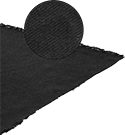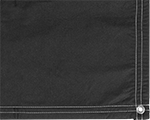Filter by
Material
Maximum Temperature
Flammability Rating
Color
Backing Type
System of Measurement
DFARS Specialty Metals
Minimum Temperature
Fabric Weight
Maximum Temperature in a Vacuum
Breathable
Securing Method
Water Resistance
Grommet ID
Grommet Material
Grommet Spacing
UV Resistant
Minimum Temperature for Flexibility
Fire-Retardant Carbon Fiber Sheets

Even when exposed for as long as 2 minutes to temperatures up to 2600° F, these sheets, made of a carbon fiber blend, won't ignite or melt. They also resist molten metal spatter. This fabric meets ASTM standards for materials.
| Wd. | Thick. | Density, oz./sq. yd. | Max. Temperature, °F | Specifications Met | Color | Max. Lg., ft. | Per Ft. | |
| 60" | 0.02" | 11 | 800° | ASTM F1506 | Black | 150 | 0000000 | 000000 |
Carbon Fiber Fabric Strips

Use these strips, made of a heat-stabilized carbon fiber blend, for high-temperature seals and heat insulation.
| Wd. | Thick. | Max. Temperature, °F | Max. Temperature in a Vacuum, °F | Color | Lengths, ft. | Per Ft. | |
| 1" | 1/16" | 700° | 5000° | Black | 00000000 | 00000 | |
| 1" | 1/8" | 700° | 5000° | Black | 00000000 | 0000 | |
| 2" | 1/16" | 700° | 5000° | Black | 00000000 | 0000 | |
| 2" | 1/8" | 700° | 5000° | Black | 00000000 | 0000 | |
| 3" | 1/16" | 700° | 5000° | Black | 00000000 | 0000 | |
| 3" | 1/8" | 700° | 5000° | Black | 00000000 | 0000 | |
| 4" | 1/16" | 700° | 5000° | Black | 00000000 | 0000 | |
| 4" | 1/8" | 700° | 5000° | Black | 00000000 | 00000 |
Ultra Heat- and Flame-Resistant Tarps
The most heat-resistant tarps we offer, these resist flames and molten metal splatter.

Grommet | ||||||||||||
|---|---|---|---|---|---|---|---|---|---|---|---|---|
| Wd. | Lg. | Thick., mil | ID | Spacing | Material | Water Resistance | Breathable | UV Resistant | Min. Temperature for Flexibility | Color | Each | |
Sheet | ||||||||||||
Carbon Fiber Fabric | ||||||||||||
| 5' | 5' | 150 | 3/8" | 2' | Brass | None | No | No | Not Rated | Black | 000000 | 0000000 |
| 6' | 8' | 150 | 3/8" | 2' | Brass | None | No | No | Not Rated | Black | 000000 | 000000 |
| 8' | 10' | 150 | 3/8" | 2' | Brass | None | No | No | Not Rated | Black | 000000 | 000000 |
| 10' | 12' | 150 | 3/8" | 2' | Brass | None | No | No | Not Rated | Black | 000000 | 00000000 |
| Per Sq. Ft. | ||||||||||||
| Other | Other | 150 | 3/8" | 2' | Brass | None | No | No | Not Rated | Black | 000000 | 00000 |

























